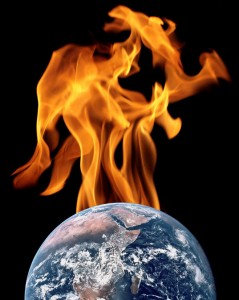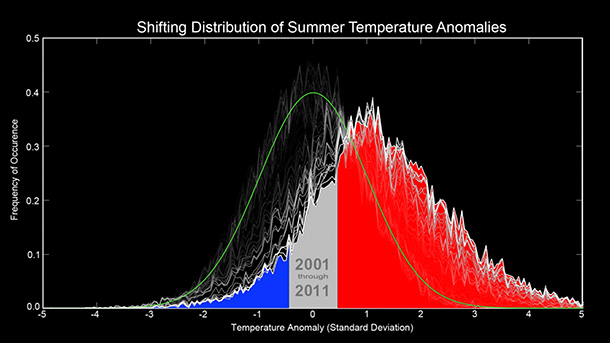Create a free profile to get unlimited access to exclusive videos, sweepstakes, and more!
Is It Hot in Here, or Is It Just Global Warming?

Â
Let me be clear right off the top: global warming is real. There is vastly overwhelming evidence for it and scientific consensus about it, and the only people still sowing doubt about it appear to be motivated more by ideology and corporate interests than scientific evidence.
Having said that, one thing I'm careful about when I talk about it is linking specific weather events to the worsening climate. We humans like to connect events if they occur at the same time, whether they are actually connected or not. So when huge storms spawning tornadoes ravaged the midwest last year, I was careful not to say it was caused by global warming. When a huge glacier calved off Greenland a few weeks ago, I was careful not to say it was caused by global warming. When Greenland got a tremendous burst of warm air that caused unprecedented ice melting, I was careful not to say it was caused by global warming. When wildfires erupted over the US and Russia this summer, I was careful not to say it was caused by global warming. I said these events are all consistent with global warming, but not necessarily caused by it.
Now, however, things have changed. New evidence has arisen that indicates the extreme heat waves that are cooking the US are in fact and in deed caused by global warming.
[UPDATE: Talk about timing: the NOAA just released their State of the Climate report, showing that July 2012 is the hottest month ever recorded in the history of the contiguous United States.]
Climate scientist James Hansen - who, in the 1980s, was the first to talk about the idea that the planet is heating up - has published research linking global warming and these extreme events. It's explained in an article on the NASA site: Hansen and his team looked at northern hemisphere surface temperatures going back to the early 1950s. At any given time, some places are hotter than average, some cooler. So they plotted these temperature deviations from average and got a bell curve, just like the bell curve some teachers use to grade students. Most temperatures are near the average value, while very hot or very cold places are less common; the graph peaks in the middle and falls away to either side.
All well and good. But when they plotted these temperatures over time - looking at the average temperature for a given year as well as the extreme events - they saw three things, none of them good. One was that, over time, the average temperature moved to the right - that is, the the overall temperature got hotter. Second, there were fewer cooler temperatures - the graph on the left got weaker. Third, there were more extreme heating events - the graph got stronger on the right.
The green line shows the smoothed average curve for the time period of 1951 - 1980. The filled in part shows the curve for the decade of 2001 - 2011. Note that it's skewed right, and there are more hot events as well.
It hasn't been your imagination. We're getting hotter, and we're seeing more extremely hot summers. You can confirm this for yourself: walk outside.
Personal anecdotes aside, the data back that conclusion up. Statistically speaking, the temperature "anomalies" are highly significant, meaning they are almost certainly real. In the 1950s, extreme heat waves like we're seeing now were rare to nonexistent. Today, 10% of the northern hemisphere experiences these heat waves. Dr. Hansen says that without global warming, these anomalies wouldn't be happening. In other words, our warming planet is the culprit behind these extreme events.
This doesn't mean every summer will be hotter than the last, or have worse heat waves. But as Dr. Hansen points out, it does mean that in general that's what we'll see. Climate Scientist Michael Mann describes it this way:
Â
It is not simply a set of random events occurring in isolation, but part of a broader emerging pattern. We are seeing, in much of the extreme weather we are experiencing, the "loading of the weather dice." Over the past decade, records for daily maximum high temperatures in the U.S. have been broken at twice the rate we would expect from chance alone. Think of this as rolling double sixes twice as often as you'd expect â something you would readily notice in a high stakes game of dice. Thus far this year, that ratio is close to 10 to 1. That's double sixes coming up ten times as often as you expect.
Â
What Dr. Hansen's research shows is that again, while any specific event is hard to blame in its entirety on global warming, the overall trend we're seeing - including these disastrous heat waves causing deaths, massive crop failures, drought, and wildfires - is linked to global warming. As he put it:
 ”
This summer people are seeing extreme heat and agricultural impacts. We're asserting that this is causally connected to global warming, and in this paper we present the scientific evidence for that.
Â
That's a pretty firm commitment. And one that will, no doubt, make heads explode amongst climate change denialists. They will obfuscate, they will nitpick, they will distract, they will deny. But they are wrong. The media, and more importantly, politicians, need to understand that.
Again, as Dr. Mann says (emphasis mine):
Â
The time for debate about the reality of human-caused climate change has now passed. We can have a good faith debate about how to deal with the problem â how to reduce future climate change and adapt to what is already upon us to reduce the risks that climate change poses to society. But we can no longer simply bury our heads in the sand.
Â
As I've said before: when does weather become climate? It's starting to feel like now.
Â
Â
Â
Image credit: NASA/Goddard Space Flight Center Scientific Visualization Studio
Â
Â
Â
Related Posts:
- New study clinches it: the Earth is warming up
- Climate change: the evidence
- New independent climate study confirms global warming is real
- 2011: The 9th hottest year on record
Â
Â




























